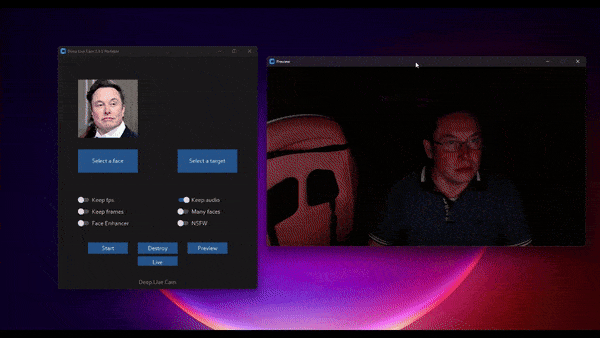Combating Deepfakes with Blockchain and Artificial Intelligence
PLUS: How It Could Fuel Your Next Big Startup
This is the go-to newsletter and community for breaking down complex AI research into actionable insights and startup ideas.
🚀 Hey Innovators, Welcome Back!
This week, we’re tackling a critical issue in the digital age: deepfakes. As AI-generated media becomes more sophisticated, the spread of fake videos and images poses significant risks to trust and security online. But there’s hope—by combining AI with blockchain technology, we can create robust systems to detect, track, and prevent the spread of deepfakes, safeguarding the integrity of digital content.
For example, the #1 trending GitHub repo right now is Deep-Live-Cam, and it’s seriously impressive—it takes a single image and turns it into a real-time live-stream deepfake.

Deep-Live-Cam example
💡 TLDR
Summary
Deepfakes—realistic fake videos and images generated by AI—are becoming increasingly difficult to detect, posing serious threats to security, privacy, and public trust. However, by leveraging blockchain’s immutable ledger and AI’s analytical capabilities, we can build systems to combat the creation and distribution of deepfakes. Blockchain ensures that the authenticity of digital content can be verified, while AI algorithms detect and flag manipulated media. Together, these technologies offer a powerful solution to one of the most pressing challenges in today’s digital landscape.
🔍 IN-DEPTH RESEARCH SPOTLIGHT
Topic: Combating Deepfakes with Blockchain and AI
Research Source: Bellagarda, J.S., & Abu-Mahfouz, A.M. (2022). "An Updated Survey on the Convergence of Distributed Ledger Technology and Artificial Intelligence."
Main Points:
The Deepfake Problem: Deepfakes use AI, particularly generative adversarial networks (GANs), to create hyper-realistic fake videos and images. These can be used maliciously to spread misinformation, manipulate public opinion, and damage reputations.
AI-Driven Detection: AI can be employed to detect deepfakes by analyzing subtle inconsistencies in videos and images that are often invisible to the human eye. These AI models can be trained to identify markers of manipulation, such as unnatural facial movements or inconsistencies in lighting and shadows.
Blockchain’s Role: Blockchain can create an immutable record of digital content at the point of creation. This ensures that any modifications to the content can be traced, making it easier to verify the authenticity of media files. By storing metadata on the blockchain, such as timestamps and digital fingerprints, the original, unaltered version of a video or image can always be referenced.
Combining AI and Blockchain: The integration of AI and blockchain offers a dual-layer defense against deepfakes. AI algorithms can continuously scan the web for deepfakes, while blockchain ensures that content authenticity can be verified. When a deepfake is detected, its digital fingerprint can be recorded on the blockchain, preventing further distribution and making it easier to track the source.
Real-World Applications:
Media Verification: News outlets and social media platforms can use AI and blockchain to verify the authenticity of videos before they are published, reducing the spread of misinformation.
Legal and Compliance: Organizations can leverage these technologies to protect their brands from deepfake attacks, ensuring that any fake content is quickly identified and removed.
Digital Rights Management: Blockchain can be used to manage the ownership and rights of digital content, making it difficult for deepfakes to be used without detection.
The Bottom Line: The combination of AI and blockchain technologies provides a powerful solution to the deepfake problem. By detecting and verifying content in real-time, these tools can protect individuals, organizations, and societies from the harmful effects of manipulated media.
📈 CURRENT TRENDS
Key Developments in Deepfake Detection and Prevention:
AI-Enhanced Forensics: New AI models are being developed to improve the accuracy of deepfake detection by focusing on more complex and nuanced aspects of video manipulation.
Blockchain-Based Verification Tools: Companies are launching blockchain-based platforms that allow creators to register their digital content, making it easier to prove authenticity and detect unauthorized alterations.
Industry Collaborations: Media companies and tech giants are increasingly collaborating on AI and blockchain initiatives to tackle the deepfake problem collectively, ensuring more comprehensive coverage and protection.
🚀 STARTUP IDEAS WORTH EXPLORING
Here are some startup ideas inspired by the battle against deepfakes:
Deepfake Detection API: Develop an AI-powered API that can be integrated into social media platforms and news websites to automatically detect and flag deepfake content before it’s published.
Blockchain-Based Content Registry: Create a blockchain-based platform where content creators can register and verify their digital media, ensuring authenticity and tracking any alterations.
Real-Time Media Authentication Tool: Build a browser extension that uses AI and blockchain to verify the authenticity of videos and images in real-time, providing users with a trust score for the content they view online.
AI-Driven Compliance Service: Launch a service that helps organizations monitor their digital presence for deepfakes, using AI to detect fakes and blockchain to manage and verify authentic content.
Digital Rights Management Platform: Develop a platform that uses blockchain to manage the ownership and distribution rights of digital content, preventing the unauthorized use of media in deepfake creations.
🔮 LOOKING AHEAD
As deepfakes become more sophisticated, the need for advanced detection and verification tools will only grow. The combination of AI and blockchain offers a promising path forward, enabling the creation of more secure, trustworthy digital environments. Innovators in this space have the opportunity to shape the future of digital media by developing tools that protect authenticity and combat misinformation.
📚 Dive Deeper: Read the Full Papers
For those interested in exploring further, check out the full research paper that inspired this newsletter:
Title: An Updated Survey on the Convergence of Distributed Ledger Technology and Artificial Intelligence
Authors: Jagger S. Bellagarda & Adnan M. Abu-Mahfouz
Link: Read the full paper

